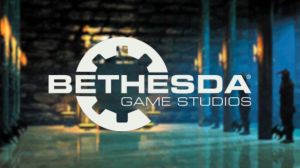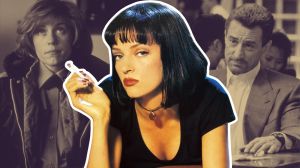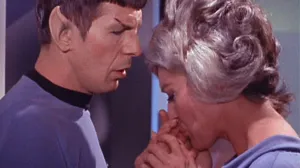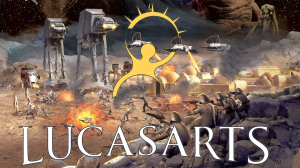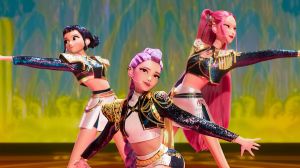Harley Quinn occupies a unique space within the DC Comics pantheon, a character whose creation subverted the typical comic book origin story. Unlike heroes and villains who leap from the printed page into other media, Dr. Harleen Quinzel emerged fully formed in animation, her chaotic energy and undeniable charm making her a fan-favorite character that would later be included in DC Comics. This unconventional start foreshadowed a journey defined by constant evolution and reinvention. From the Joker’s lovestruck sidekick to an independent anti-hero navigating trauma and seeking redemption, Harley has undergone some of the most significant character transformations in DC’s history, becoming a wildly popular, complex, and commercially vital figure.
Videos by ComicBook.com
With Harley Quinn remaining a fixture across comics, film, television, and gaming, her extensive and often contradictory history can be a whirlwind for newcomers. This guide aims to cut through the chaos, providing a clear roadmap through her key comic book appearances. We’ll explore her roots, track her journey towards independence, highlight the essential stories that define her evolution, and offer the best starting points for readers ready to dive headfirst into the madcap world of Harley Quinn.
Animated Origins and Early Comics (1992-1999)
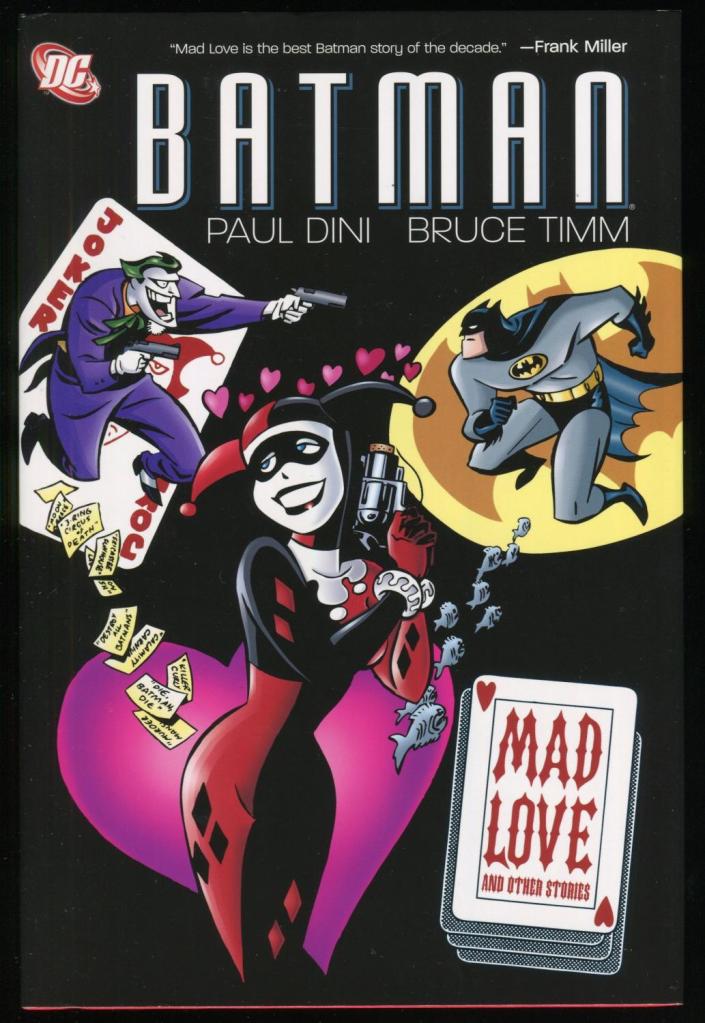
Harley Quinn’s story famously begins not in ink, but in animation. Writer Paul Dini and artist Bruce Timm created her for the Batman: The Animated Series episode “Joker’s Favor,” which aired in September 1992. Initially intended as a one-off comedic foil for the Joker, inspired by actress Arleen Sorkin’s performance in a soap opera jester sequence, Harley’s snappy personality and Sorkin’s distinctive voice performance made her an instant hit with viewers. This audience connection, forged entirely outside of comics, fundamentally shaped her trajectory, as her immense popularity was established before she ever appeared in a DC comic book.
Quickly becoming a recurring character in the DC Animated Universe (DCAU), Harley’s role expanded beyond just being the Joker’s girlfriend. The 1993 episode “Harley and Ivy” was pivotal, establishing her enduring friendship and partnership with Poison Ivy, offering Harley a significant relationship dynamic independent of the Joker. Other key episodes like “Harley’s Holiday” explored her chaotic attempts at a normal life post-Arkham, while “Harlequinade” showcased her complex morality, teaming her with Batman against a Joker plot she found too extreme. These early animated appearances laid crucial groundwork, demonstrating her capacity for friendship, flashes of independence, and a moral compass, however skewed.
Harley’s first foray into the comic book medium came with The Batman Adventures #12 in September 1993. Written by Kelley Puckett with art by Mike Parobeck, this comic existed within the animated series’ continuity. The story, “Batgirl: Day One,” saw Harley and Ivy crash a costume party, marking Harley’s debut on the printed page, albeit in a supporting role. Despite being non-canonical to the main DC Universe at the time, the issue became a highly sought-after collector’s item, a testament to the massive popularity generated solely by her animated appearances.
The definitive origin story for this iteration arrived with The Batman Adventures: Mad Love in 1994. This Eisner Award-winning one-shot, crafted by Dini and Timm, meticulously detailed Dr. Harleen Quinzel’s transformation. It portrayed her as an ambitious Arkham psychologist tragically manipulated by the Joker, who preyed on her sympathy and desire to make a name for herself until she fell obsessively in love. Mad Love provided the essential psychological depth and tragic framework, establishing the abusive relationship with the Joker as the central trauma defining her initial characterization. Its impact was enormous, serving as the blueprint for future origin stories and cementing the core tragedy of her beginnings.
Finally, after years of animated stardom, Harley Quinn was officially integrated into the main DC Comics continuity in Batman: Harley Quinn #1 (October 1999). Written by Dini with art by Yvel Guichet, this prestige one-shot cleverly placed her within the “No Man’s Land” event. Found injured by Poison Ivy after Joker tried to kill her, Harley recounts her origin. Dini adapted the story for the darker DCU tone and crucially introduced a significant change: Poison Ivy administered a serum that granted Harley enhanced strength, agility, and toxin immunity. This power boost made her a credible threat within the main DCU’s established power levels. Framing the origin as a story told to Ivy also cemented their bond as foundational to Harley’s canonical existence from the outset.
- Batman: The Animated Series (“Joker’s Favor,” “Harley and Ivy,” “Harley’s Holiday”) – Establishes core personality, Joker dynamic, and crucial Ivy friendship.
- The Batman Adventures #12 – First comic book appearance (in DCAU continuity).
- The Batman Adventures: Mad Love – The definitive, foundational origin story exploring her manipulation by Joker.
- Batman: Harley Quinn #1 – Official integration into the main DC Universe; establishes Ivy’s role and Harley’s powers.
First Solo Series & Gotham City Sirens (2000-2011)

Following her successful DCU integration, Harley stepped into her own spotlight with Harley Quinn #1 in December 2000. This first ongoing solo series, primarily written by Karl Kesel with distinctive art by Terry and Rachel Dodson, marked a crucial phase in her development. The series saw Harley attempting to strike out on her own, distancing herself (initially) from the Joker to carve her own chaotic path in Gotham. She formed her own crew, the “Quinntets,” and tried her hand at being a crime boss, interacting with characters like Two-Face, Catwoman, and Poison Ivy. Kesel explored her motivations, emphasizing her complex, often self-destructive nature while maintaining a generally lighthearted, comedic tone that balanced humor with drama.
A significant later chapter arrived with Gotham City Sirens, launched in June 2009 by Harley’s co-creator Paul Dini and artist Guillem March. Running for 26 issues, the series centered on the uneasy alliance and cohabitation of Harley, Poison Ivy, and Catwoman in a Gotham adjusting to Bruce Wayne’s apparent death. Proposed by Catwoman for mutual protection, the trio navigated threats like Hush and Gaggy (Joker’s original sidekick) while dealing with internal friction. For Harley, Sirens provided a vital space to interact with female peers, exploring friendship, rivalry, and support outside the Joker’s shadow. Most importantly, it became fertile ground for developing the Harley/Ivy relationship. Dini layered romantic undertones into their interactions, showcasing Ivy’s protectiveness and Harley’s reliance on her. Issue #24 featured Harley directly asking Ivy if she was in love with her, pushing their bond towards explicit romance.
However, Gotham City Sirens also starkly highlighted Harley’s central conflict at the time. Her genuine desire for connection, represented by her alliance with Ivy and Catwoman, constantly battled her deeply ingrained toxic bond with the Joker. The team ultimately fractured precisely because Harley couldn’t entirely sever that psychological dependence, underscoring that her journey to true emancipation was still ongoing in the pre-New 52 continuity. Another key story from this period is Detective Comics #831, also by Paul Dini, which subtly showed early hints of Harley’s potential for redemption after her release from Arkham, suggesting a capacity for moving beyond pure villainy even before her major reinventions.
- Harley Quinn (2000) #1-8 (“Preludes and Knock-Knock Jokes”) – First solo series; attempts at independence, forming the Quinntets.
- Gotham City Sirens #1-7 (“Union”) – Establishes the team dynamic with Catwoman and Poison Ivy; explores early trust issues.
- Gotham City Sirens #20-26 (“Division”) – Highlights the Harley/Ivy bond development and the team’s fracture due to Joker’s influence.
- Detective Comics #831 – A Paul Dini story showing early hints of Harley’s potential for redemption.
New 52 Reinvention (2011-2016)

The 2011 New 52 reboot brought a significant overhaul for Harley Quinn, launching her into new territory both visually and narratively. Her journey began as a core member of Task Force X in the relaunched Suicide Squad series by writer Adam Glass and artist Federico Dallocchio. Recruited by Amanda Waller, this marked Harley’s first comics association with the Squad, placing her on a prominent team outside Gotham.
The initial portrayal was darker, more violent, and unstable, accompanied by a controversial redesign inspired by the Arkham video games that swapped her jester suit for a revealing corset-and-shorts look. Furthermore, a controversial origin tweak emerged, suggesting the Joker pushed her into ACE Chemicals, bleaching her skin and visually tying her transformation directly to him, contrasting with her previous Ivy-empowered origin. Despite criticism, her Suicide Squad tenure massively boosted her popularity and cemented her status as the team’s breakout star, driving its future adaptations.
The most defining chapter of this era unfolded within the Harley Quinn solo series launched in November 2013, helmed by writers Amanda Conner and Jimmy Palmiotti, with Chad Hardin as the initial primary artist. This run enacted a radical shift, deliberately moving Harley from Gotham to Coney Island, Brooklyn, giving her space to cultivate her own identity. Inheriting a building filled with eccentric tenants like Big Tony, Sy Borgman, and the taxidermied beaver Bernie, Harley built a new life. The series embraced a unique tone: wildly comedic, surreal, fourth-wall-breaking, and unapologetically violent, yet filled with surprising heart. It successfully navigated the controversial redesign by focusing on personality and humor, solidifying Harley as a chaotic anti-hero. Key storylines saw her forming the “Gang of Harleys,” teaming up with Power Girl, and confronting the Joker in “The Joker’s Last Laugh” to save her new love interest, Mason Macabre.
Crucially, Poison Ivy was a frequent supporting character throughout the Conner and Palmiotti run, and they took the groundbreaking step of confirming their romantic relationship. This development, built upon years of subtext, culminated in Harley Quinn #25 featuring their first (near) explicit on-panel kiss. The Conner and Palmiotti era redefined Harley for a new generation, proved her solo viability outside Gotham, and canonized the Harlivy romance, cementing her A-list status.
- Suicide Squad (2011) #1-7 (“Kicked in the Teeth”) – New 52 debut on the team; darker tone, controversial redesign, and origin tweak.
- Harley Quinn (2013) #22-25 (“The Joker’s Last Laugh”) – Harley confronts Joker to protect her new life, showing significant character growth within the Conner/Palmiotti run.
- Harley Quinn (2013) #25 – Features the first near-explicit on-panel Harlivy kiss, confirming their romance within the Conner/Palmiotti run.
Rebirth and Redemption Arc (2016-Present)
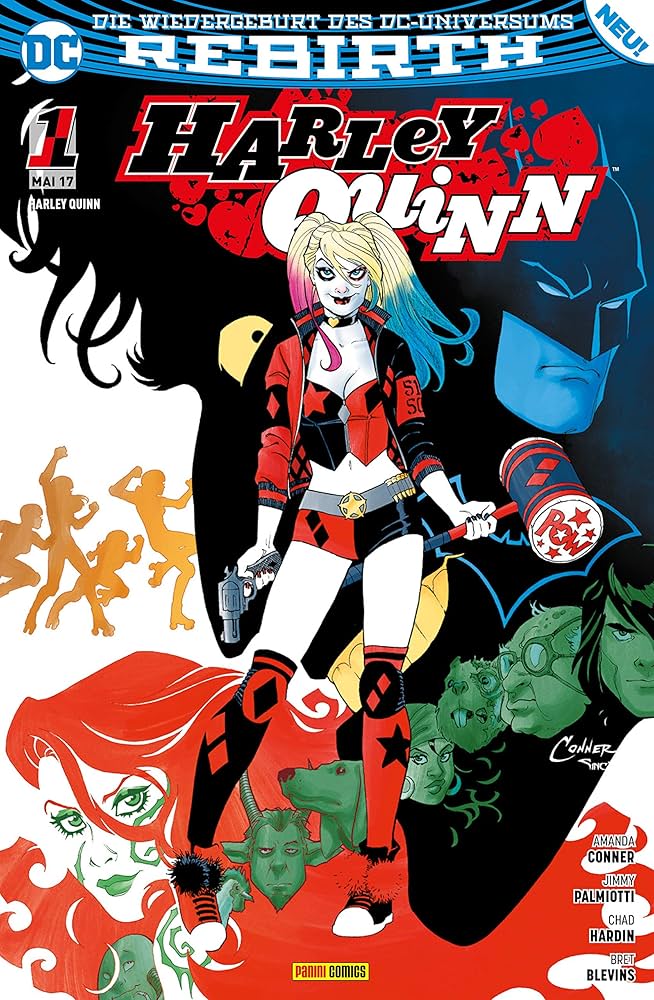
DC’s 2016 Rebirth initiative aimed to blend modern elements with classic legacy, but for Harley Quinn, the transition was notably smooth. Recognizing the success of Conner and Palmiotti’s run, DC allowed their Harley Quinn solo series to relaunch with a new #1 but retain the same creative team, Coney Island setting, supporting cast, and signature comedic anti-hero tone. This continuation underscored Harley’s unique status, as her series operated as a self-sustaining ‘Harley-verse.’ Conner and Palmiotti continued delivering beloved stories involving corrupt mayors, copycat villains (Harley Sinn), and even a Coney Island zombie apocalypse before concluding their celebrated tenure with issue #34.
Following a brief interim period, Sam Humphries took over writing duties in 2018, aiming to reintegrate Harley more closely with the mainstream DCU and explore her emotional depth as a survivor. His run featured ambitious arcs like “Harley vs. Apokolips” (#45-49), where she teamed with Granny Goodness and introduced Petite Tina, and a meta-textual issue #50 breaking DC continuity. A significant focus was Harley processing her mother’s death through cosmic trials (“Trials of Harley Quinn,” #62-66) and relocating to Los Angeles to become a wrestler (“Queen Harleen”), investigating a murder with ties to Granny Goodness and Booster Gold (linking to Heroes in Crisis). Humphries’ run shifted the tone towards emotional depth and trauma recovery while bringing Harley back into the DCU’s main currents.
Stephanie Phillips began writing Harley Quinn in 2021 as part of Infinite Frontier, with Riley Rossmo providing a distinctive initial art style. This run marked another major shift: Harley returned to Gotham City, determined to atone for her past and actively work towards heroism, seeking acceptance from the Bat-family. Phillips heavily explored themes of redemption, accountability, processing trauma, and using Harley’s psychological background for good. She introduced Kevin, a former Joker goon also seeking redemption, as Harley’s sidekick, and antagonists like Keepsake and Verdict were tied directly to Harley’s past crimes. Key arcs forced Harley to confront the lethal consequences of her time with Joker (“Verdict,” #13-17) and involved multiversal shenanigans (“Who Killed Harley Quinn?”). During this era, the Harley/Ivy relationship was portrayed as stable but often long-distance.
Harley’s elevated status was further reflected in her pivotal roles in major DC events. “Heroes in Crisis” (2018-2019) placed her at the center of a murder mystery at a superhero trauma center, forcing her to confront her abuse and impacting her relationship with Ivy. The “Joker War” (2020) event saw Harley actively aid Batman, battle Joker’s new partner Punchline (the “anti-Harley”), and make a definitive break from the Joker’s cycle of violence, solidifying her heroic alignment. Her integration into these large-scale events demonstrates her journey from a character operating somewhat separately to one deeply embedded in the core conflicts of the DC Universe, grappling with her past while striving for a better future.
- Harley Quinn (2016) #1-34 – Continuation of Conner/Palmiotti’s run into Rebirth, maintaining the popular Coney Island status quo.
- Harley Quinn (2018) #45-49 (“Harley vs. Apokolips”) – Humphries’ run begins, reintegrating Harley with the wider DCU.
- Harley Quinn (2018) #62-66 (“Trials of Harley Quinn”) – Explores Harley dealing with grief through cosmic trials.
- “Heroes in Crisis” (2018-2019) – Major event exploring trauma; Harley is a central character, significantly impacting her and Ivy.
- “Joker War” (Batman #92-100, Harley Quinn #75) (2020) – Harley plays a key role fighting Joker and Punchline, cementing her break from her past.
- Harley Quinn (2021) #13-17 (“Verdict”) – Harley confronts the consequences of her past actions with Joker during Phillips’ run.
Best Entry Points for New Readers
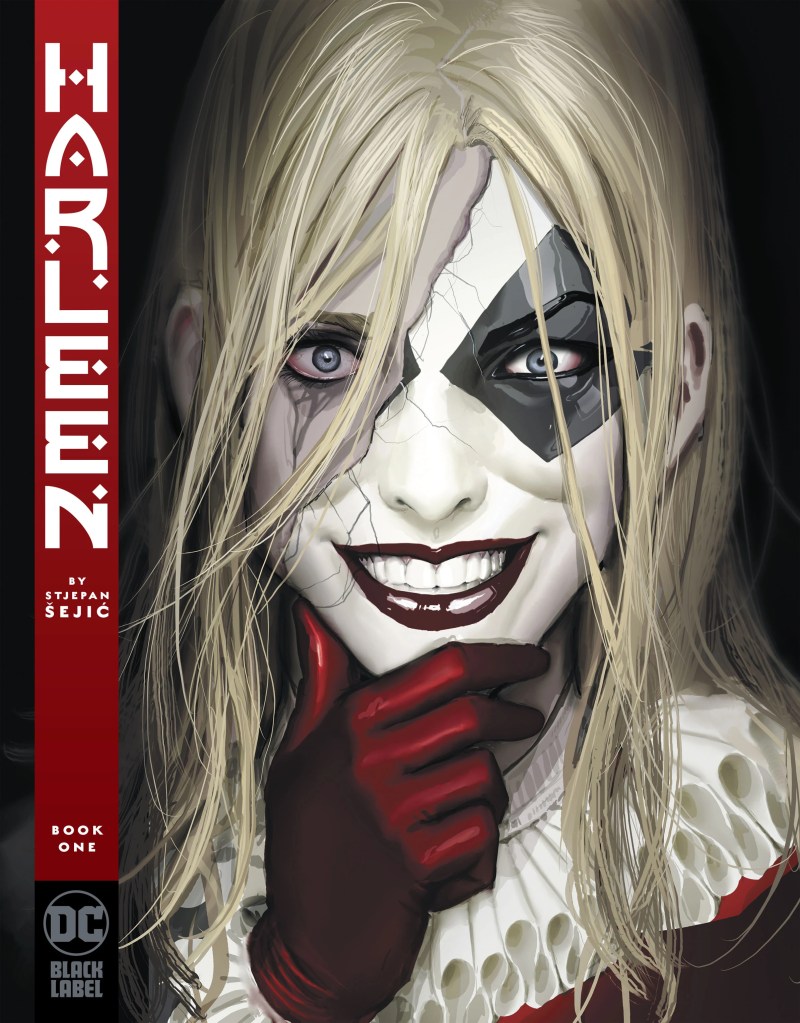
Harley Quinn’s journey spans multiple continuities, creative teams, and tonal shifts, which can make finding the perfect first read feel like navigating Arkham Asylum blindfolded. Thankfully, some key stories serve as excellent introductions, capturing different facets of her character and requiring minimal prior knowledge.
For readers eager to experience the modern, independent Harley that dominated the 2010s, Harley Quinn Vol. 1: Hot in the City is the ideal starting point. Collecting the initial issues of Amanda Conner and Jimmy Palmiotti’s wildly popular New 52 run, with art primarily by Chad Hardin, this volume marks a definitive shift. It deliberately moves Harley away from Gotham and the Joker’s orbit, relocating her to Coney Island, where she inherits a building full of eccentric characters and tries to build her own life. The tone is outrageously comedic, gleefully violent, and full of heart, establishing the anti-hero persona that defined Harley for much of the last decade. It’s designed to be welcoming to new readers, focusing on fun, absurdity, and Harley’s uniqueness outside the Bat-family drama.
[RELATED: Comics Starter Pack: A Beginner’s Guide to Lex Luthor]
Alternatively, Harleen offers a more mature and psychologically intense exploration of Harley’s origins. Written and stunningly illustrated by Stjepan Šejić for DC’s Black Label imprint, this miniseries provides a modern, nuanced retelling of Harleen Quinzel’s descent. It expands significantly on the classic Mad Love origin, portraying her manipulation by the Joker as a gradual, complex process rooted in her own ambitions, empathy, and vulnerabilities. The artwork is breathtaking, and the story delves deep into the psychological horror of her transformation. While darker than Hot in the City, its critical acclaim and sophisticated character study make it a compelling entry for readers seeking a deeper understanding of Harley’s beginnings, functioning as a standalone story.
For those wanting to jump into Harley’s most recent adventures and her current status quo, Harley Quinn Vol. 1: No Good Deed serves as an excellent entry point. Collecting the first six issues of Stephanie Phillips’ 2021 run with art by Riley Rossmo, this story marks Harley’s return to Gotham City with a clear mission: redemption. Taking place after the events of Joker War, Harley actively tries to atone for her past villainy and work alongside the Bat-family. It introduces her earnest sidekick Kevin and explores themes of accountability and using her skills for good. This starting point requires little prior knowledge beyond the basic premise of Harley seeking to be a hero, making it perfect for readers wanting the current, Gotham-based version of the character.
- Harley Quinn Vol. 1: Hot in the City (2014) – Kicks off the popular modern comedic anti-hero era in Coney Island.
- Harleen (2019) – A mature, visually stunning, and psychologically deep modern origin retelling.
- Harley Quinn Vol. 1: No Good Deed (2021) – Starts the current redemption-focused era with Harley back in Gotham.
What other Harley Quinn stories would you recommend to comic book beginners? Let us know in the comments!


